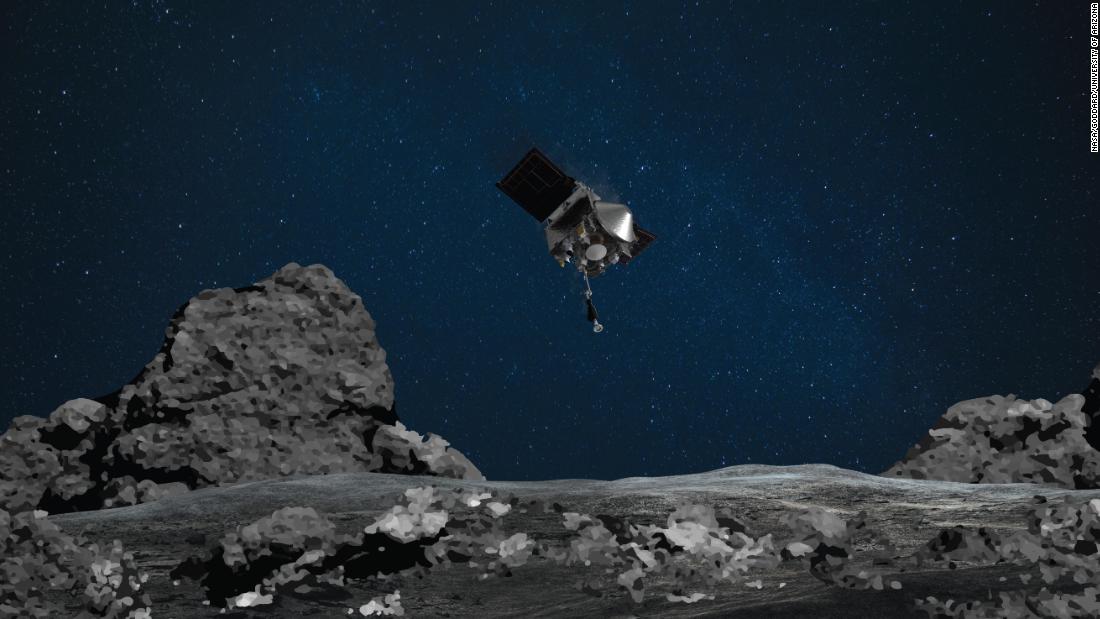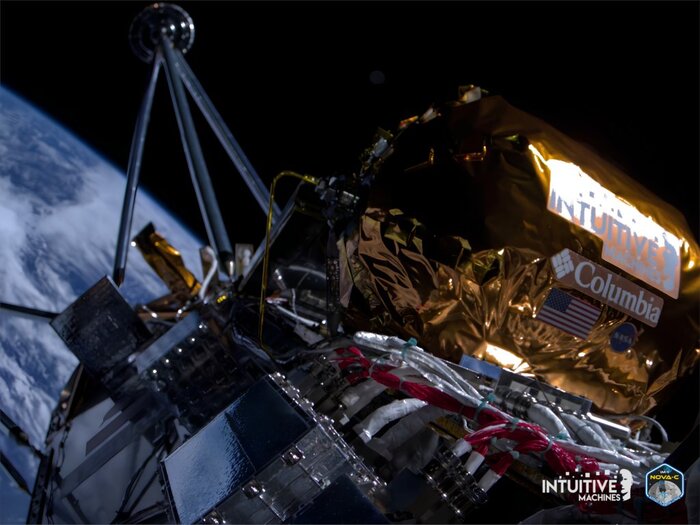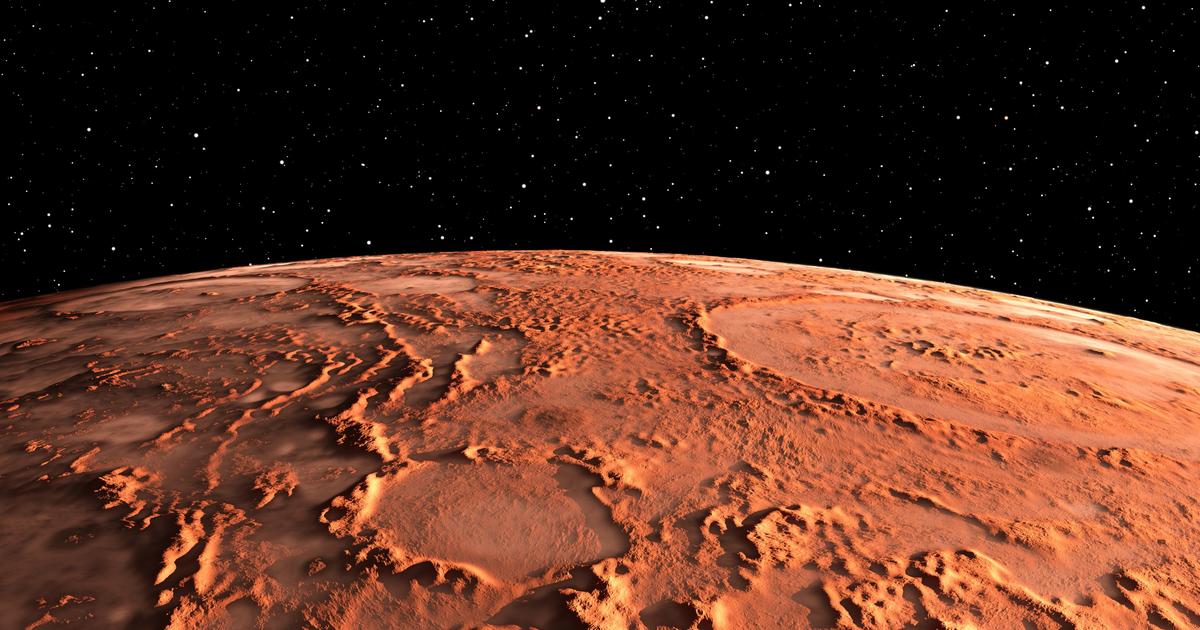NASA will broadcast live the descent into an asteroid 1:07
(CNN) -
After orbiting the near-Earth asteroid Bennu for nearly two years, NASA's OSIRIS-REx spacecraft is ready to extend its robotic arm and collect a sample from the asteroid's surface on Tuesday.
That sample will be brought to Earth in 2023.
A spaceship the size of a pickup truck has to briefly rest its arm on a landing site called Nightingale.
The site is the width of some parking spaces.
The arm will collect a sample between 57 grams and 2 kilograms before moving back to a safe place.
The place itself is located inside a crater the size of a tennis court.
And it's surrounded by rocks the size of a building.
Located more than 320 million km from Earth, Bennu is a rock-studded asteroid shaped like a top.
It is as tall as the Empire State Building.
It is a "pile of debris" asteroid, which is a group of rocks held together by gravity rather than a single object.
The mission was launched in September 2016. Its name means in Spanish Explorer of Origins, Spectral Interpretation, Resource Identification and Regolith Security.
advertising
Since arriving at Bennu, the spacecraft and its cameras have been collecting and sending data and images to help the team learn more about the asteroid's composition.
You are mapping the best potential sites to collect samples.
The mission's main event is scheduled for October 20 starting at 5 p.m. ET.
It's called a Touch-and-Go sample collection event, or TAG ("Touch and Go").
Bennu has an orbit that brings it closer to Earth, which is why it is considered a nearby asteroid.
One of its future approaches could bring it dangerously close to Earth sometime in the next century.
It has a 1 in 2,700 chance of impacting our planet.
The Bennu samples could help scientists understand more about asteroids that could impact Earth.
And also about how planets formed and life began.
«It is a first historical mission for NASA, to bring an asteroid sample.
And it is difficult".
So said Thomas Zurbuchen, associate administrator for NASA's Science Mission Directorate, during a news conference Monday.
'Bennu is almost a Rosetta stone and tells the story of our Earth and our solar system over the last billions of years.
Bennu has presented many challenges.
But the ingenuity of the team has allowed us to get to where we are.
MIRA
: NASA grants Nokia a contract to install 4G network on the Moon
What to expect
Instead of the so-called "seven minutes of terror" of trying to land the Perseverance rover on Mars next year, the OSIRIS-REx team anticipates "4.5 hours of mild anxiety."
This, according to Beth Buck, the mission operations program manager at Lockheed Martin Space in Littleton, Colorado.
During this time, the spacecraft will descend from its orbit around the asteroid and eventually get close enough to touch it.
The asteroid and the spacecraft are currently about 330 million km from Earth, which will cause a communication delay of about 18.5 minutes.
The NASA team will broadcast a live animation describing what is happening.
Based on the commands that have already been sent to OSIRIS-REx hours before for the sample collection sequence.
The spacecraft will go through the entire sequence of approaching the asteroid and collecting the sample autonomously as live commands from Earth will not be possible.
Touch an asteroid
The event will take around 4.5 hours to unfold.
And the spacecraft will perform three maneuvers to collect the sample.
The spacecraft will first fire thrusters to leave its safe orbit around the asteroid, which is about 760 meters away from the surface.
And it will travel for four hours before reaching just 125 meters away.
The spaceship will then adjust to position and speed to continue descending.
Next, OSIRIS-REx will slow its descent to point to a path to match the asteroid's rotation during contact.
Its solar panels will fold into a Y-wing configuration over the spacecraft to protect them.
At last, OSIRIS-REx will descend for less than 16 seconds.
The spacecraft will fire a bottle of pressurized nitrogen at the asteroid, using the gas as a way to lift material off Bennu's surface.
The spacecraft's harvester head will capture the churning material.
This head, located on the 10-foot-long robotic sampling arm, is the only part of the spacecraft that Bennu will touch.
The team likens it to an air filter on a vintage car model, perfect for collecting fine material.
Small discs, which can collect dust like sticky pads, are also located on the head in case part of the sampling maneuver does not go as planned.
LOOK
: Another asteroid, recently discovered, passes close to Earth
After the event
A camera on the spacecraft will take pictures of the collection event.
The OSIRIS-REx spacecraft will have to detect hazards and delay its own mission if an obstacle gets in the way of sample collection.
Based on their simulations, the team estimates that there is less than a 6% chance that the spacecraft will abort the mission.
By Tuesday night, the team should be able to confirm whether the mission happened successfully.
The images will be returned by the spacecraft on Wednesday.
This will provide more details on the sample collection and how the spacecraft is doing.
The team estimates that they will have a mass measurement of the sample on Saturday.
By October 30, NASA will confirm whether the spacecraft collected enough sample.
Or if you need to make another sample collection attempt in January at another place called Osprey.
But if all goes well, the spacecraft and its prized sample will begin the long journey back to Earth next year and land the sample on Earth in 2023.
AsteroidNASA













